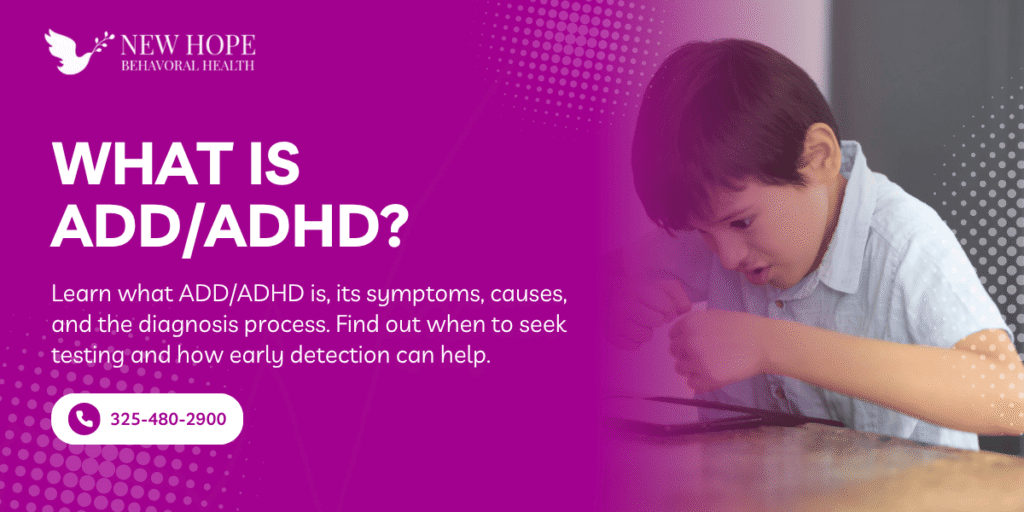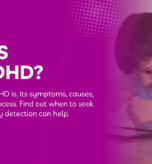
What is ADD/ADHD? Symptoms, Causes & How to Get Tested
Attention-Deficit/Hyperactivity Disorder (ADHD) — historically split into ADD for inattentive types and ADHD as the modern umbrella term — is a neurodevelopmental condition marked by persistent patterns of inattention, hyperactivity, and/or impulsivity that interfere with daily life. It affects both children and adults, presents differently from person to person, and is diagnosed through careful clinical evaluation rather than a single medical test.
Why This Matters
- Untreated ADHD can affect every area of life — school, work, relationships, and mental health.
- Early recognition opens the door to effective treatment and support, from therapy and coaching to medication.
ADD vs. ADHD — What’s the Difference?
- ADD (Attention Deficit Disorder) is an older term for primarily inattentive presentations without hyperactivity.
- ADHD is the official term used in current medical diagnosis, which includes:
- Predominantly Inattentive (formerly called ADD)
- Predominantly Hyperactive-Impulsive
- Combined Presentation
- Today, clinicians use “ADHD” for all subtypes, but “ADD” still appears in everyday language.
Types of ADHD
- Inattentive Type: Difficulty focusing, frequent mistakes, forgetfulness.
- Hyperactive-Impulsive Type: Restlessness, talking excessively, acting without thinking.
- Combined Type: A mix of inattentive and hyperactive symptoms.
Core Symptoms — At a Glance
Inattentive Symptoms
- Trouble sustaining attention in tasks or play
- Frequent careless mistakes
- Not listening when spoken to directly
- Difficulty organizing tasks and activities
- Avoiding tasks that require prolonged focus
- Frequently losing necessary items (keys, school materials)
- Being easily distracted
- Forgetfulness in daily routines
Hyperactive-Impulsive Symptoms
- Fidgeting, tapping, or squirming
- Difficulty staying seated when expected
- Running or feeling restless (in adults, internal restlessness)
- Talking excessively
- Interrupting conversations
- Difficulty waiting turns
- Acting without thinking
Children vs. Adults — How Symptoms Show Up
- Children: Symptoms often emerge before age 12, becoming more noticeable when school demands focus and organization. Teachers often report attention and behavior concerns.
- Adults: Hyperactivity may shift into an internal sense of restlessness. Common struggles include time management, organization, emotional regulation, and meeting work or personal responsibilities.
Common Co-Occurring Conditions
- Anxiety disorders
- Depression
- Learning disabilities
- Behavioral disorders (in some children)
- Substance use issues (in some untreated adults)
What Causes ADHD?
ADHD doesn’t have a single cause — it results from a mix of factors:
- Genetics: Runs in families; highly heritable.
- Brain Differences: Variations in brain structure, function, and chemical signaling.
- Environmental Factors: Prenatal exposures, premature birth, and early-life adversity may contribute.
How is ADHD Diagnosed?
Diagnosis is a multi-step process that may include:
- Medical & developmental history review.
- Symptom checklists & questionnaires for parents, teachers, or self-report.
- Clinical interview with a mental health professional.
- Rule-out of other conditions with similar symptoms.
- Cognitive or neuropsychological testing when needed.
Key criteria: Symptoms must be present in more than one setting, start before age 12 (though sometimes recognized later), and cause significant life impact.
When to Seek an Assessment
Consider professional testing if:
- Symptoms persist for 6+ months and disrupt daily life.
- Work, school, or relationships suffer despite effort.
- There’s a consistent pattern of disorganization, distraction, or impulsivity.
- Family members or teachers have raised ongoing concerns.
Treatment & Support Options
- Education & awareness — Understanding ADHD and learning strategies.
- Behavioral interventions — Structure, routines, and organizational tools.
- Therapy/coaching — Skills for time management, focus, and emotional regulation.
- Medication — Stimulants and non-stimulants prescribed when appropriate.
- Accommodations — Adjustments at school or work to support success.
- Lifestyle changes — Better sleep, regular exercise, balanced diet.
Myths vs. Facts
- Myth: ADHD is laziness or bad parenting.
Fact: ADHD is a medical condition with biological roots. - Myth: Only kids get ADHD.
Fact: Many adults have ADHD, often undiagnosed until later in life. - Myth: ADHD looks the same in everyone.
Fact: Symptoms vary widely by age, gender, and type.
Preparing for an ADHD/ADD Assessment
- Bring past school reports, evaluations, and a list of challenges and strengths.
- Ask your clinician about their testing process and timeline.
- Expect a clear next step after diagnosis — not just a label.
Strengths of the ADHD Mind
ADHD isn’t only about challenges — many with ADHD excel in creativity, problem-solving, and high-energy environments. The right strategies can turn these traits into powerful strengths.
Final Thoughts — And How to Take Action
If you suspect ADHD/ADD in yourself or your child, an assessment can be the first step toward clarity, effective support, and a better quality of life.
Schedule Your ADHD Test Today — or Call to Book Your Appointment and take the first step toward understanding and thriving.




